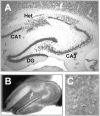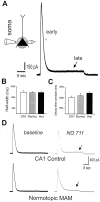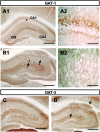Heterotopic neurons with altered inhibitory synaptic function in an animal model of malformation-associated epilepsy
- PMID: 12196583
- PMCID: PMC6757980
- DOI: 10.1523/JNEUROSCI.22-17-07596.2002
Heterotopic neurons with altered inhibitory synaptic function in an animal model of malformation-associated epilepsy
Abstract
Children with brain malformations often exhibit an intractable form of epilepsy. Although alterations in cellular physiology and abnormal histology associated with brain malformations has been studied extensively, synaptic function in malformed brain regions remains poorly understood. We used an animal model, rats exposed to methylazoxymethanol (MAM) in utero, featuring loss of lamination and distinct nodular heterotopia to examine inhibitory synaptic function in the malformed brain. Previous in vitro and in vivo studies demonstrated an enhanced susceptibility to seizure activity and neuronal hyperexcitability in these animals. Here we demonstrate that inhibitory synaptic function is enhanced in rats exposed to MAM in utero. Using in vitro hippocampal slices and whole-cell voltage-clamp recordings from visualized neurons, we observed a dramatic prolongation of GABAergic IPSCs onto heterotopic neurons. Spontaneous IPSC decay time constants were increased by 195% and evoked IPSC decay time constants by 220% compared with age-matched control CA1 pyramidal cells; no change in IPSC amplitude or rise time was observed. GABA transport inhibitors (tiagabine and NO-711) prolonged evoked IPSC decay kinetics of control CA1 pyramidal cells (or normotopic cells) but had no effect on heterotopic neurons. Immunohistochemical staining for GABA transporters (GAT-1 and GAT-3) revealed a low level of expression in heterotopic cell regions, suggesting a reduced ability for GABA reuptake at these synapses. Together, our data demonstrate that GABA-mediated synaptic function at heterotopic synapses is altered and suggests that inhibitory systems are enhanced in the malformed brain.
Figures







References
-
- Andermann F. Cortical dysplasias and epilepsy: a review of the architectonic, clinical, and seizure patterns. Adv Neurol. 2000;84:479–496. - PubMed
-
- Andre V, Marescaux C, Nehlig A, Fritschy JM. Alterations of hippocampal GABAergic system contribute to development of spontaneous recurrent seizures in the rat lithium-pilocarpine model of temporal lobe epilepsy. Hippocampus. 2001;11:452–468. - PubMed
-
- Avoli M, Bernasconi A, Mattia D, Olivier A, Hwa GG. Epileptiform discharges in the human dysplastic neocortex: in vitro physiology and pharmacology. Ann Neurol. 1999;46:816–826. - PubMed
-
- Baraban SC, Schwartzkroin PA. Electrophysiology of CA1 pyramidal neurons in an animal model of neuronal migration disorders: prenatal methylazoxymethanol treatment. Epilepsy Res. 1995;22:145–156. - PubMed
Publication types
MeSH terms
Substances
Grants and funding
LinkOut - more resources
Full Text Sources
Medical
Miscellaneous
